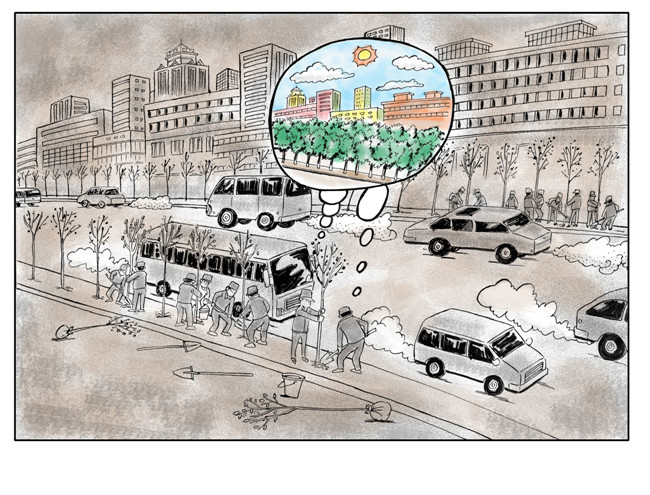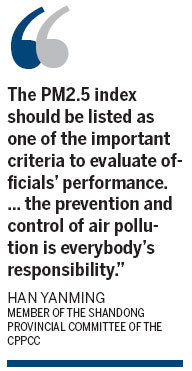|
 |
| Xu Baisheng/ For China Daily |
Debates triggered by worst air pollution in nation's history, report Sun Li in Xiamen, Zhao Ruixue in Jinan, Zhang Xiaomin in Dalian and He Na in Beijing.
Few public issues have generated so much discussion, unease, hatred and a general feeling of helplessness as the gray blanket of smog that descended across China last year as the country experienced the worst air pollution in its history.
Data from the China Meteorological Administration show that during December almost half the country, including 25 provinces and regions and more than 100 first- and second-tier cities, was shrouded in dense smog.
However, the four worst incidents came in January last year when most of central and eastern China was affected and visibility was reduced to less than 100 meters in the worst-hit areas.

When the meteorological administration recently reported its top 10 major climate events of 2013, the four incidents were lumped together and ranked the most important weather incident of the year.
The Chinese word for smog is mai, a complicated character that involves 22 separate pen or brush strokes and is difficult to pronounce, let alone write.
However, since smog became big news in China, mai has cropped up with increasing regularity in conversations, in TV and radio reports, on social media and the Internet, giving this almost-obsolete word a new lease on life.
Just as some foreigners are said to open every conversation with a comment about the weather, an increasing number of Chinese seem to have adopted the habit. A glance at the sky and a muttered mai has almost replaced the traditional greeting of Ni chi le, ma? meaning, "Have you eaten?"
One result of this raised awareness is that smog has become the hottest topic on the agendas of the ongoing provincial and city "two sessions" meetings, the most important annual event in China's political calendar at both the local and central level, centered around lawmakers meeting at provincial People's Congresses and political advisers gathering at sessions of the Chinese People's Political Consultative Conference.
Special meeting
Hebei province is one of the regions most severely affected by air pollution. In a bid to improve the air quality, the authorities added a new session - a special meeting to discuss and approve the Report on the Prevention and Control of Air Pollution produced by the provincial authorities.
Aiming to lower the concentration of airborne PM2.5 - particulate matter with a diameter of 2.5 micrometers or less - by 4 percent, the report proposed strict controls on emissions from businesses in the steel, coal and metallurgical sectors, and on vehicles. In addition, the province will also improve controls on emissions from pharmaceutical businesses and medical institutes. It will also establish an air pollution control network and prevention system with input from the general public. Finally, the province will draw up a series of compensatory awards to be paid by the worst polluters.
During its recent two sessions, Lanzhou, the capital of Gansu province and another of the cities badly affected by smog in recent years, suggested the strictest control measures in China. The measures included the adoption of an administrative accountability system for air pollution, the establishment of an environmental protection bureau attached to the local police authorities and the use of online environmental tests.
It's hardly surprising that some of the places most affected by smog, such as Beijing, Tianjin, and the provinces of Hebei, Shanxi, Gansu and Henan, have introduced some of the strictest measures to tackle the problem, but even areas with a national, or even international, reputation for good weather and clear air placed smog at the top of the agenda during their two sessions.
They had good reason to do so; even China's cleanest city - Sanya, on the island province of Hainan - was unable to escape the gray blanket and was wreathed in smog from Oct 20 to 26. The problem also affected Lhasa, the capital of the Tibet autonomous region, which stands at an average altitude of more than 3,600 meters, in December, causing flights to be suspended.
|